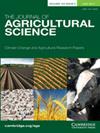Sensitivity of Azuki Bean and Control of Multiple Herbicide-Resistant Canada Fleabane With Saflufenacil Herbicide Mixtures
IF 2.2
4区 农林科学
Q2 AGRICULTURE, MULTIDISCIPLINARY
引用次数: 0
Abstract
During 2021 and 2022, four experiments were conducted to ascertain the sensitivity of azuki bean to saflufenacil herbicide mixtures, and five experiments were conducted to determine the control of multiple herbicide-resistant (MHR) Canada fleabane with various saflufenacil herbicide mixtures applied preplant (PP) in soybean at various locations in southwestern Ontario, Canada. At 1, 2, 4, and 8 weeks after emergence (WAE), glyphosate + saflufenacil caused 2-5% azuki bean injury. The addition of metribuzin, bromoxynil, halauxifen-methyl, or 2,4-D ester caused 2-7%, 2-4%, 4-9%, and 2-4% azuki bean injury, respectively. Glyphosate + saflufenacil + bromoxynil plus either metribuzin, halauxifen-methyl, or 2,4-D ester caused 3-7%, 5-11%, and 3-6% azuki bean injury, respectively. Saflufenacil mixtures evaluated had no adverse effect on azuki bean stand, biomass m-1, biomass plant-1, height, seed moisture content, or yield. At 4 and 8 weeks after application (WAA), glyphosate + saflufenacil control MHR Canada fleabane 93 and 87%, respectively; there was no improvement in MHR Canada fleabane control with the glyphosate + saflufenacil mixtures evaluated. At 8 WAA, saflufenacil herbicide mixtures evaluated reduced MHR Canada fleabane density 43-95% and biomass 47-96%; differences were not statistically significant. MHR Canada fleabane interference reduced soybean yield 50%; however, reduced MHR Canada fleabane interference with all glyphosate + saflufenacil mixtures evaluated resulted in soybean yield that was similar to the weed-free control. This study concludes that saflufenacil herbicide mixtures evaluated have the potential to be used for the control MHR Canada fleabane in azuki bean.阿月浑子的敏感性和使用 Saflufenacil 除草剂混合物控制多种抗除草剂的加拿大金花菜
2021 年和 2022 年期间,在加拿大安大略省西南部不同地点进行了四次试验,以确定茨木豆对氟虫腈除草剂混合物的敏感性,并进行了五次试验,以确定在大豆播种前(PP)施用各种氟虫腈除草剂混合物对多种抗除草剂(MHR)加拿大飞燕草的控制效果。在出苗后 1、2、4 和 8 周(WAE),草甘膦 + 氟虫腈会造成 2-5% 的红豆伤害。添加灭幼脲、溴虫腈、甲基噻虫嗪或 2,4-D 酯分别会造成 2-7%、2-4%、4-9% 和 2-4% 的茨木豆损伤。草甘膦+氟虫腈+溴虫腈+甲基立枯磷、甲基噻唑膦或 2,4-D 酯分别造成 3-7%、5-11% 和 3-6% 的茨木豆受害。所评估的 Saflufenacil 混合物对红豆的株高、生物量 m-1、生物量 plant-1、株高、种子含水量或产量均无不利影响。施药后 4 周和 8 周(WAA),草甘膦 + 氟虫腈对 MHR 加拿大飞燕草的控制率分别为 93% 和 87%;草甘膦 + 氟虫腈混合物对 MHR 加拿大飞燕草的控制没有改善。在 8 WAA 时,所评估的 saflufenacil 除草剂混合物可使 MHR 加拿大飞蓬密度减少 43-95%,生物量减少 47-96%;差异无统计学意义。MHR 加拿大飞蓬的干扰使大豆产量降低了 50%;然而,使用所有草甘膦+氟虫腈混合物降低 MHR 加拿大飞蓬的干扰后,大豆产量与无杂草对照相似。本研究的结论是,所评估的氟虫腈除草剂混合物有可能用于控制加拿大MHR飞蓬在红豆中的生长。
本文章由计算机程序翻译,如有差异,请以英文原文为准。
求助全文
约1分钟内获得全文
求助全文
来源期刊

Journal of Agricultural Science
农林科学-农业综合
CiteScore
2.80
自引率
5.00%
发文量
68
审稿时长
1.4 months
期刊介绍:
The Journal of Agricultural Science publishes papers concerned with the advance of agriculture and the use of land resources throughout the world. It publishes original scientific work related to strategic and applied studies in all aspects of agricultural science and exploited species, as well as reviews of scientific topics of current agricultural relevance. Specific topics of interest include (but are not confined to): all aspects of crop and animal physiology, modelling of crop and animal systems, the scientific underpinning of agronomy and husbandry, animal welfare and behaviour, soil science, plant and animal product quality, plant and animal nutrition, engineering solutions, decision support systems, land use, environmental impacts of agriculture and forestry, impacts of climate change, rural biodiversity, experimental design and statistical analysis, and the application of new analytical and study methods (including genetic diversity and molecular biology approaches). The journal also publishes book reviews and letters. Occasional themed issues are published which have recently included centenary reviews, wheat papers and modelling animal systems.
 求助内容:
求助内容: 应助结果提醒方式:
应助结果提醒方式:


